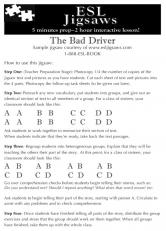ESL Jigsaws
5 Minutes Prep - 2 Hour Interactive Lesson!
Viewing entries tagged with 'beginner'
Coins and Bills for Low Beginners
As tax season approaches, we often teach a unit on money. With low beginners, I structure my unit around learning numbers, counting, asking and saying prices, the names of bills and coins, and finally the task of asking for change. I've put together some exercises for Canadian and American teachers on asking for change.
Teaching About Christmas?
Imagine you are teaching abroad for a year in the country of Slavarnia, spending part of your time in classes learning the language of Slavar. It's not a real country so follow along with this hypothetical example. The biggest holiday of the year is called Glistin. Stores close and there are two statutory holidays associated. Hallmark has commercialized Glistin significantly, creating a large gift giving fairy as the main character. But actually, the roots of the holiday are religious. When the subject of the holiday comes up in class, you read and played games centred around the Hallmark fairy, but learn nothing about the historical and religious origins of the holiday. Apparently, the school is concerned about religious proselytizing and so keeps the focus on the secular aspects. As a result, you remain in the dark about half of the holiday's significance. You have no interest in converting your religion, but just want to understand what is behind the holiday.
Cultural Differences in Gift Giving
One of the most important things we can do as ESL teachers is to help our students crack the cultural code. Gift giving has a lot of unspoken rules which may seem inscrutable to newcomers. Unconvinced? See if you were aware of these cultural attitudes to gift giving in other cultures:
Halloween Noodles
I’ve heard some teachers say that their students were not interested in participating in Halloween. Many others feel that malls are safer locations for children to go trick or treating these days. Here’s a true story of an adult ESL student of mine from Taiwan and her first Halloween here, to illustrate my view that the neighbourhood tradition of trick or treating is a worthwhile one we should teach students about.
The Library
With September being back to school time, it's a great time for a field trip to the library. This is a destination that can work well for any class from beginner to upper intermediate ESL.
Teaching about Labor / Labour Day
If you are teaching ESL to immigrants or EFL to VISA students and the topic of Labor Day in the United States or Labour Day in Canada comes up, you may find that your students also celebrate a day for workers in their home countries, but that day is usually on May 1st. A national holiday in over 80 countries, May 1st is also celebrated unofficially in many more.
Garage Sales & Thrift Stores
It's summer and I'm back on the topic of second hand shopping. If you are teaching English to new immigrants, they may see something as they walk around their neighbourhoods at this time of year that they don't have in their home countries: garage sales. Likewise, they will likely come across thrift stores or flea markets in their neighbourhoods.
Writing About Household Repairs
I'm a big fan of using picture dictionaries to teach ESL, particularly to beginner and intermediate levels. Oxford Picture Dictionary, Heinle, Word By Word, I use them all. While they are all excellent and worth purchasing, my favourite is the Oxford Picture Dictionary because the pictures are so clear and pleasing. They also have different levels.
Bargaining Language & Soft Skills
Bargaining (or haggling) takes place all over the world. North Americans often think of it as restricted to places like flea markets or garage sales, when in fact bargaining takes place in a wide variety of business transactions. Think of the negotiation involved in the purchase of expensive items, such as cars or real estate.
Mother's Day
Many teachers who teach English as an additional language are mothers. In the spirit of thanks to mothers everywhere, I'm sharing a couple pages from my low beginner holidays book for free, to use in your class. I hope you find them useful.


